Longtan Township, Taoyuan, Taiwan – Friday, May 6th, 2011
Could I count Taiwan as a new nation to the list of countries that I’d visited? To me, all signs indicated “yes”. It’s an island with clearly defined borders, an independent democratic government that rules exactly like any other sovereign entity, including issuing its own currency and passports, and has a shared sense of national identity among its citizens. As an international visitor it checks all the boxes. But whenever I posed this question to a local, the response was along the lines of “it’s complicated” or “it depends who you ask.”
Governed by the Republic of China (ROC), which ruled all of China from 1912 until the Chinese civil war in 1949 forced them to relocate to the island of Taiwan, still officially views mainland China as its territory, and the People’s Republic of China (PRC) makes the same claim to Taiwan. According to both China and Taiwan, they’re one single country… there’s just two completely contrary definitions of what that “China” is. It’s the Schrödinger’s cat of political entities; one state from any perspective within it, but two simultaneously contradictory states from any perspective outside of it. (For what it’s worth, as a non-PRC/ROC citizen, I’m still going to claim Taiwan as a separate country in my personal list.)
of China (PRC) makes the same claim to Taiwan. According to both China and Taiwan, they’re one single country… there’s just two completely contrary definitions of what that “China” is. It’s the Schrödinger’s cat of political entities; one state from any perspective within it, but two simultaneously contradictory states from any perspective outside of it. (For what it’s worth, as a non-PRC/ROC citizen, I’m still going to claim Taiwan as a separate country in my personal list.)
 I began my ten day long excursion of Taiwan at the theme park that most
I began my ten day long excursion of Taiwan at the theme park that most reflects its unique political status. With most Taiwanese having fewer opportunities to see and experience most of their own nation (besides the many museum artifacts the ROC took with them as they fled), it’s perhaps not surprising that they would use themed entertainment to make a replica of that experience instead. Welcome to Window on China Theme Park, home to dozens of miniature replicas of China’s landscapes and cultural wonders.
reflects its unique political status. With most Taiwanese having fewer opportunities to see and experience most of their own nation (besides the many museum artifacts the ROC took with them as they fled), it’s perhaps not surprising that they would use themed entertainment to make a replica of that experience instead. Welcome to Window on China Theme Park, home to dozens of miniature replicas of China’s landscapes and cultural wonders.
For being outdoor exhibits exposed to the elements (and with few guardrails to prevent wandering children), the models appeared in surprisingly well-maintained condition given their level of detail. The bonsai trees give it all a whimsical touch.
The pathways included small trenches to get a ground-level perspective on the scenes. Many paths could be a bit tight which wasn’t always ideal for navigating around (or avoiding photobombs from) other tourists.

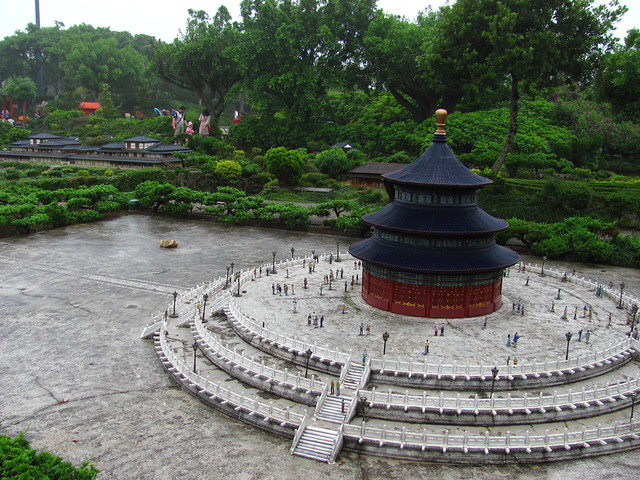


 It’s not just a models of the mainland; the park also celebrates buildings from Taiwan, like this district courthouse or university hospital. Totally as cool as the Forbidden City.
It’s not just a models of the mainland; the park also celebrates buildings from Taiwan, like this district courthouse or university hospital. Totally as cool as the Forbidden City.
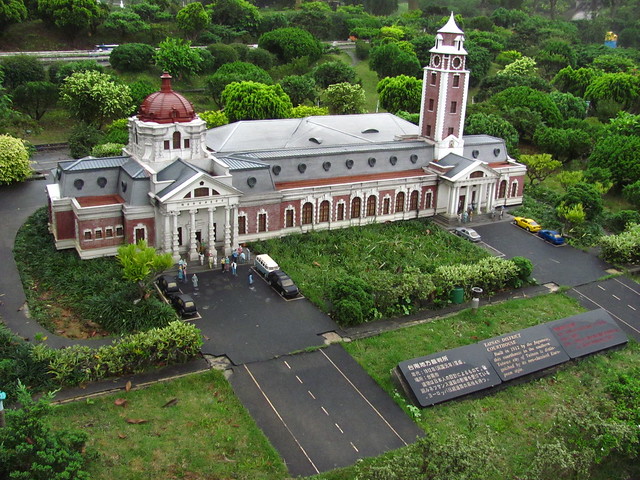

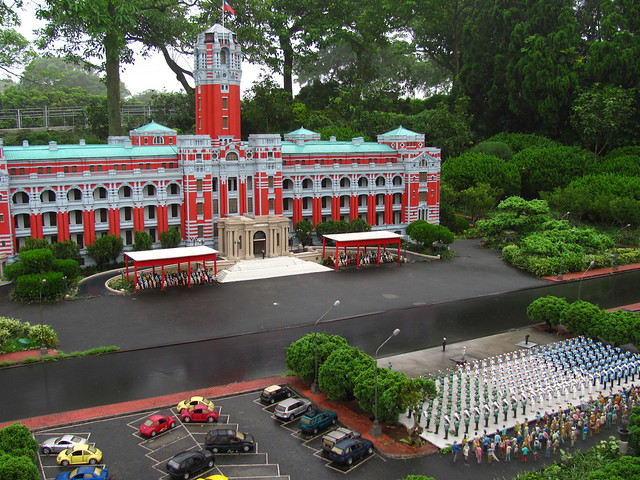
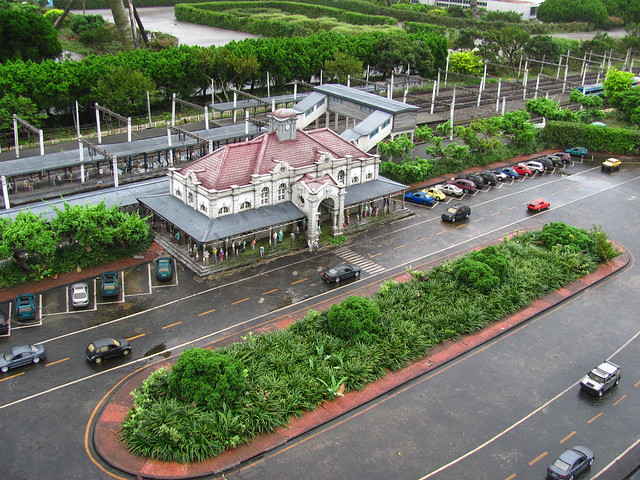 The dioramas also include a handful of working trains and other transportation to make all the hobbyists happy.
The dioramas also include a handful of working trains and other transportation to make all the hobbyists happy.
There’s even an amusement park in an amusement park. Meta.
As fascinating as this all is, its fair to say that I didn’t come here just for the miniature rides. There were full-sized rides including a couple of coasters to be found… somewhere.
At the back of the original Window on China section, there’s an oddly incongruous C.P. Huntington train station (from Wichita, Kansas!) ready to take guests to the rest of the park.
Climbing aboard, the train takes us across a big empty field to a second, larger site where all the rides are located. It’s a bit like Kentucky Kingdom, or Ocean Park Hong Kong, if only those parks weren’t divided by crucial infrastructure or a steep mountainside but by a random neighbor’s farmland who refused to sell. I’m not sure what happens to the park if the train is out of commission, as there appeared to be no other way to move visitors back and forth between the two halves.


 We were finally dropped off beneath the park’s large Nile Adventure Shoot-the-Chutes, where some random Egyptian theming was there to greet us. While the first area focuses on China, I believe the intent of this larger back area is to focus on the rest of the world. Of course that’s mostly an excuse to include a bunch of overused theme park tropes…
We were finally dropped off beneath the park’s large Nile Adventure Shoot-the-Chutes, where some random Egyptian theming was there to greet us. While the first area focuses on China, I believe the intent of this larger back area is to focus on the rest of the world. Of course that’s mostly an excuse to include a bunch of overused theme park tropes…



 There’s an indoor area that, if the map is to be believed, is supposed to have a European theme. It’s a very loose interpretation if that’s the case.
There’s an indoor area that, if the map is to be believed, is supposed to have a European theme. It’s a very loose interpretation if that’s the case.

 The top draw in this pavilion is the Laser Blaster, the park’s most thrilling coaster.
The top draw in this pavilion is the Laser Blaster, the park’s most thrilling coaster.
It’s a custom Vekoma Roller Skater, if that’s any indication of the overall thrill level found at this park. Yet it’s a fairly big layout for the genre, with a split lift hill and some fast turns in the dark. As a poor man’s Space Mountain, they certainly could have done worse.

 The other attraction in the Europe pavilion that caught my eye was the creatively named Dark Ride.
The other attraction in the Europe pavilion that caught my eye was the creatively named Dark Ride.
The queue showed promise of a more customized design than some generic off-the-shelf dark rides.
Ride in moving park benches past characters from The Dark Crystal. Well, at least it’s original in the IP it chose to rip off.
Not sure who these characters are supposed to be, or why a tree needs nipples.

 I missed out on this boat ride, which appeared to just be a slow-moving garden tour, but I later learned turns indoors for a “small world” copycat dark ride.
I missed out on this boat ride, which appeared to just be a slow-moving garden tour, but I later learned turns indoors for a “small world” copycat dark ride.

 Outside in the American zone of the park is the second and only other roller coaster, Mini Mine Train, yet another Vekoma Roller Skater.
Outside in the American zone of the park is the second and only other roller coaster, Mini Mine Train, yet another Vekoma Roller Skater.


 Mini Mine Train uses the 85 meter track configuration from Vekoma, which is quite a bit smaller than even the more famous 207 meter kiddie version found at parks around the world. It’s basically just a simple oval layout, without even a helix in the middle of it like many equivalent Zamperla or Miler models. It’s perhaps little wonder that they only ever sold two of these coasters, the other at Fiesta Texas.
Mini Mine Train uses the 85 meter track configuration from Vekoma, which is quite a bit smaller than even the more famous 207 meter kiddie version found at parks around the world. It’s basically just a simple oval layout, without even a helix in the middle of it like many equivalent Zamperla or Miler models. It’s perhaps little wonder that they only ever sold two of these coasters, the other at Fiesta Texas.
A few other attractions found around the park.



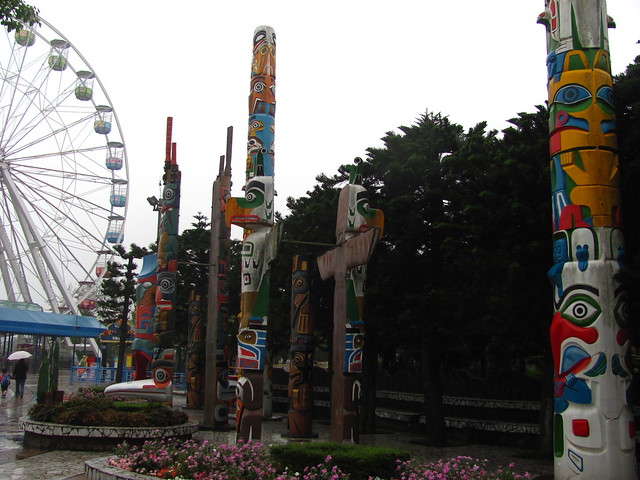 The Ferris Wheel was the only other ride I made time for, mostly to get some aerial photos of the park.
The Ferris Wheel was the only other ride I made time for, mostly to get some aerial photos of the park.

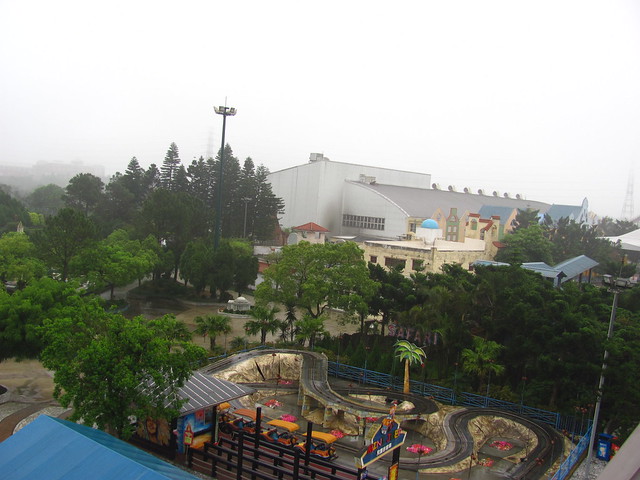




 In addition to the rides , there were also a couple of internationally-themed zones of miniatures in this area of the park. These included landmarks from America.
In addition to the rides , there were also a couple of internationally-themed zones of miniatures in this area of the park. These included landmarks from America.





 In addition to many of the usual suspects, someone at the park seemed to have a preference for modeling Frank Lloyd Wright architecture. Glad to see American architecture here is not purely represented by various European revival styles from the capitol.
In addition to many of the usual suspects, someone at the park seemed to have a preference for modeling Frank Lloyd Wright architecture. Glad to see American architecture here is not purely represented by various European revival styles from the capitol.

 There was also a section containing European landmarks. Some were quite familiar…
There was also a section containing European landmarks. Some were quite familiar…
While others were more obscure. I appreciate that there was still a sense of discovery with each model, and it wasn’t simply going down the checklist of the most popular landmarks.

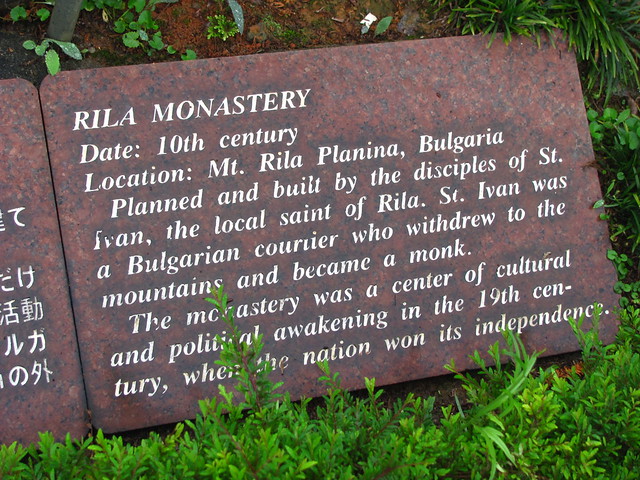
 While the detail of the models were very good, the overall presentation within the landscape was a little lacking compared to the original China-based part of the park.
While the detail of the models were very good, the overall presentation within the landscape was a little lacking compared to the original China-based part of the park.



 There’s still a few very pleasant corners to discover…
There’s still a few very pleasant corners to discover…


 There’s even a separate section for the parts of Asia that aren’t culturally Chinese, including India, Japan, Korea, and Nepal. Again, a nice mix of familiar and more obscure structures.
There’s even a separate section for the parts of Asia that aren’t culturally Chinese, including India, Japan, Korea, and Nepal. Again, a nice mix of familiar and more obscure structures.



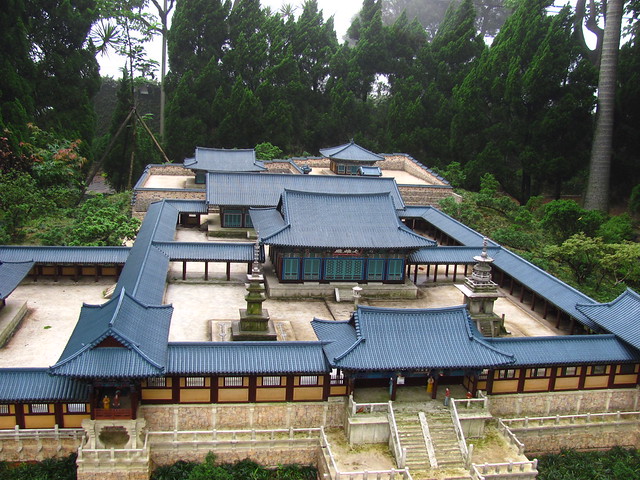



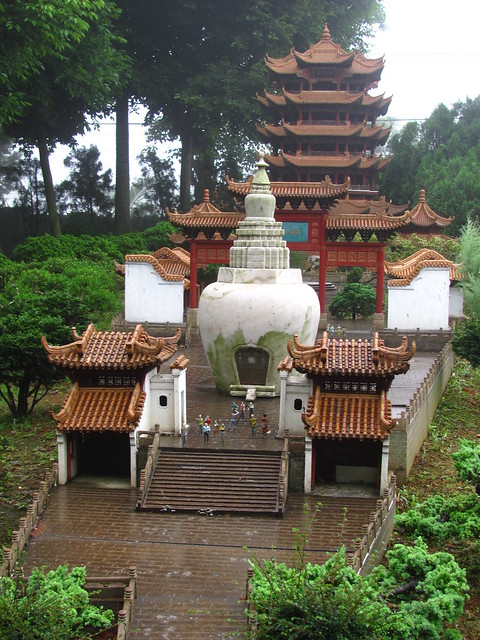
 Time to catch the train back to the front gate to head to my second destination of the day.
Time to catch the train back to the front gate to head to my second destination of the day.

 Window on China is divided into two halves in more ways than one. The areas of the park focused on miniatures are quite good, clearly assembled with a lot of care and artistic talent. Those aren’t qualities you can always easily find in a small family regional park like this. The amusement section, by contrast, would rate at the bottom of the Taiwanese theme parks I tried in terms of both ride quality and thematic detail. It’s not bad, but there’s very little memorable or worth repeating. Even its best attraction, a custom indoor Vekoma coaster, is outshone by other custom indoor Vekoma coasters at competing parks around Taiwan. That said, the proximity to Leofoo Village Theme Park down the road and the unique quality of the miniatures (plus the two coaster credits…) still make Window on China well worth a two hour detour when in Taiwan.
Window on China is divided into two halves in more ways than one. The areas of the park focused on miniatures are quite good, clearly assembled with a lot of care and artistic talent. Those aren’t qualities you can always easily find in a small family regional park like this. The amusement section, by contrast, would rate at the bottom of the Taiwanese theme parks I tried in terms of both ride quality and thematic detail. It’s not bad, but there’s very little memorable or worth repeating. Even its best attraction, a custom indoor Vekoma coaster, is outshone by other custom indoor Vekoma coasters at competing parks around Taiwan. That said, the proximity to Leofoo Village Theme Park down the road and the unique quality of the miniatures (plus the two coaster credits…) still make Window on China well worth a two hour detour when in Taiwan.



















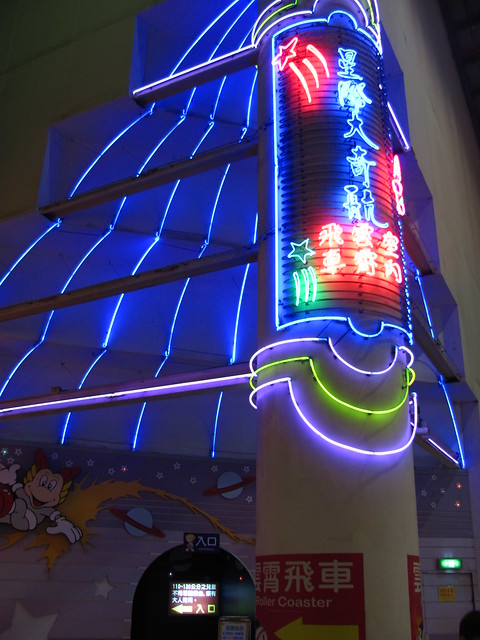
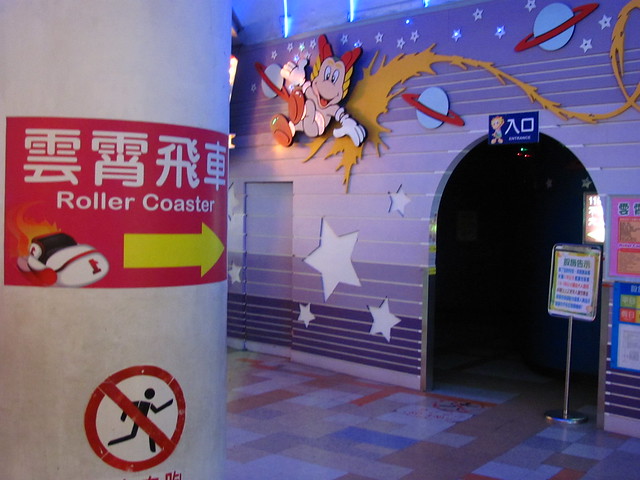
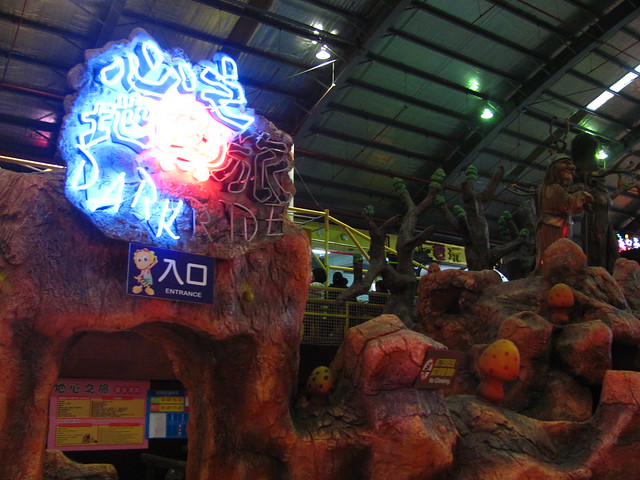



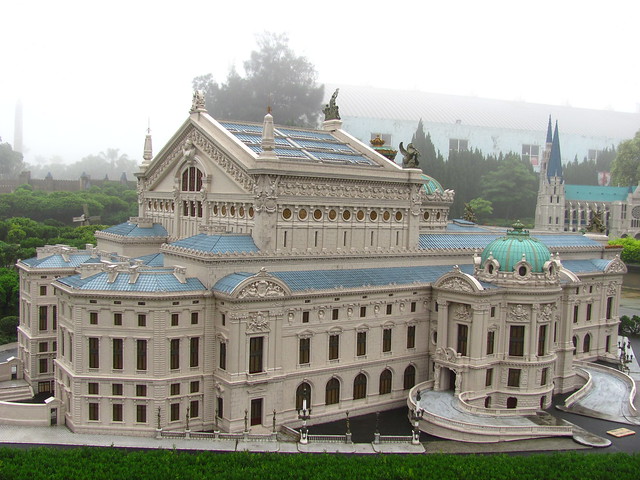



Comments